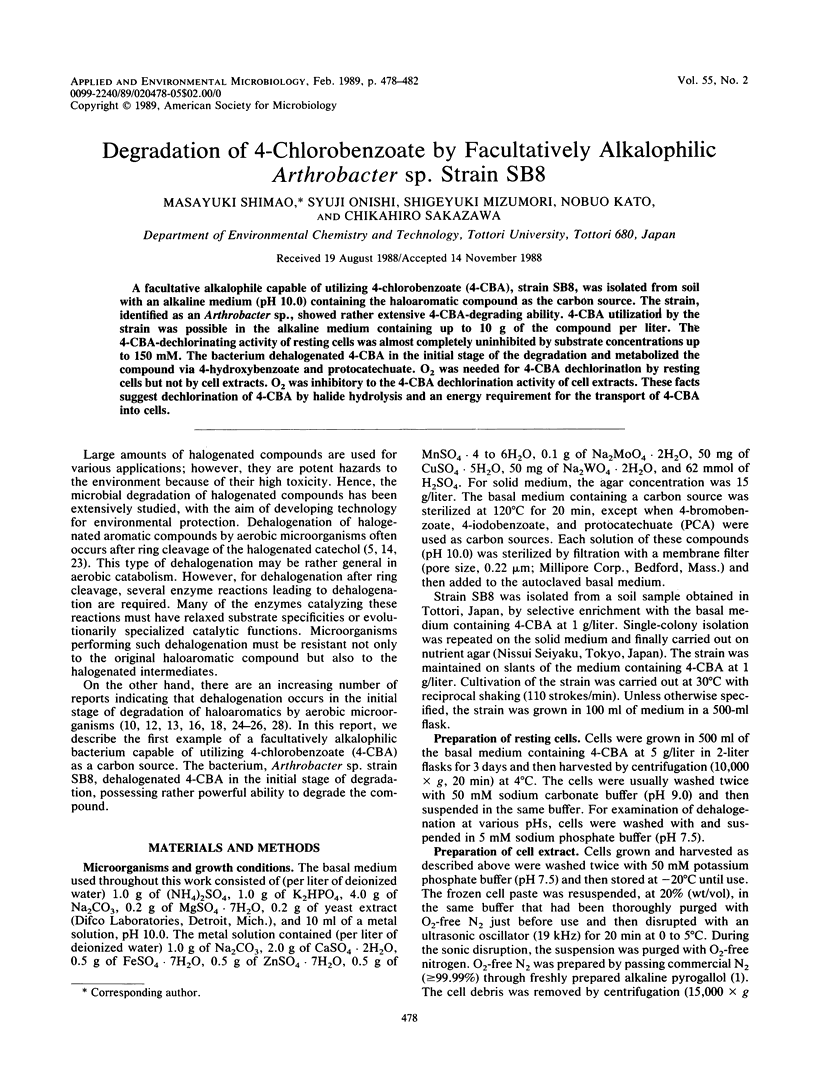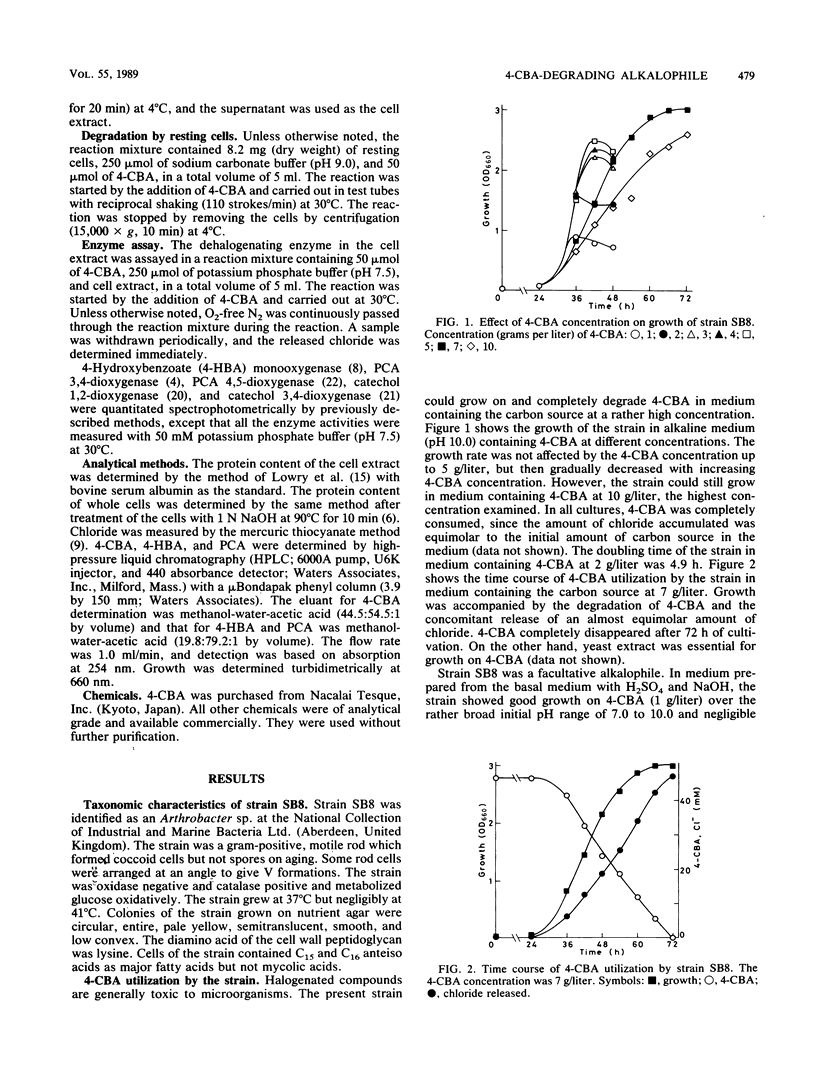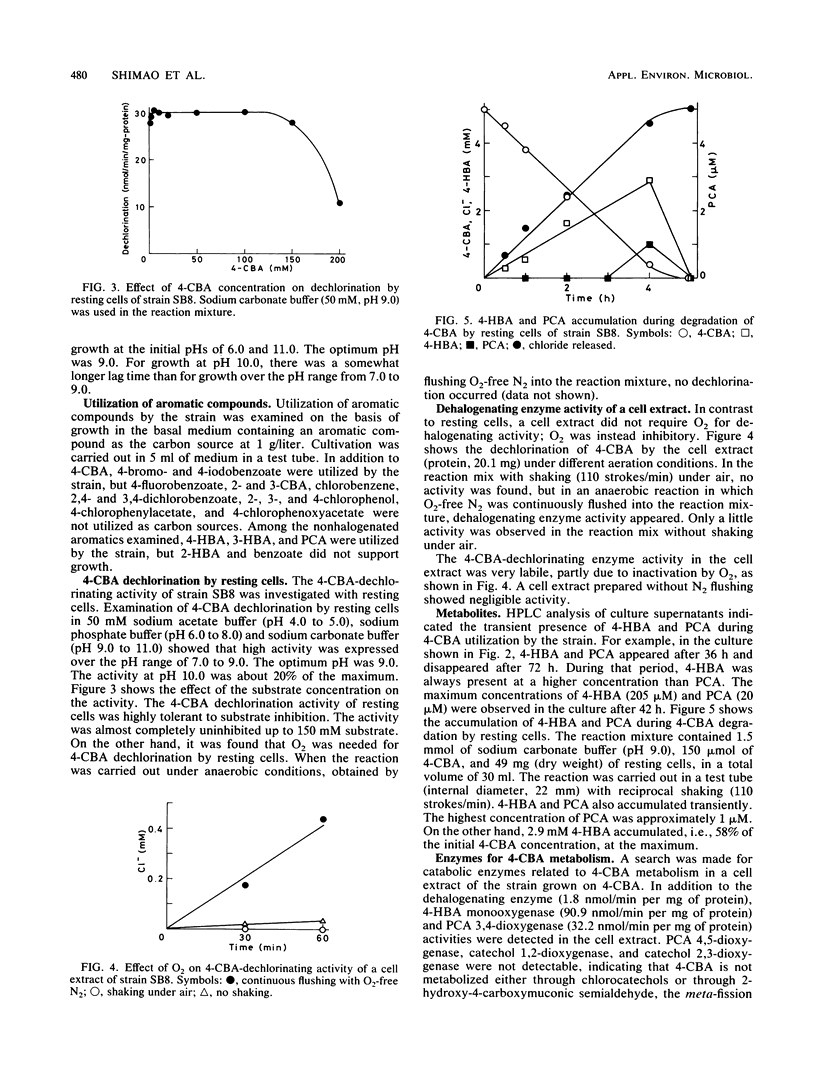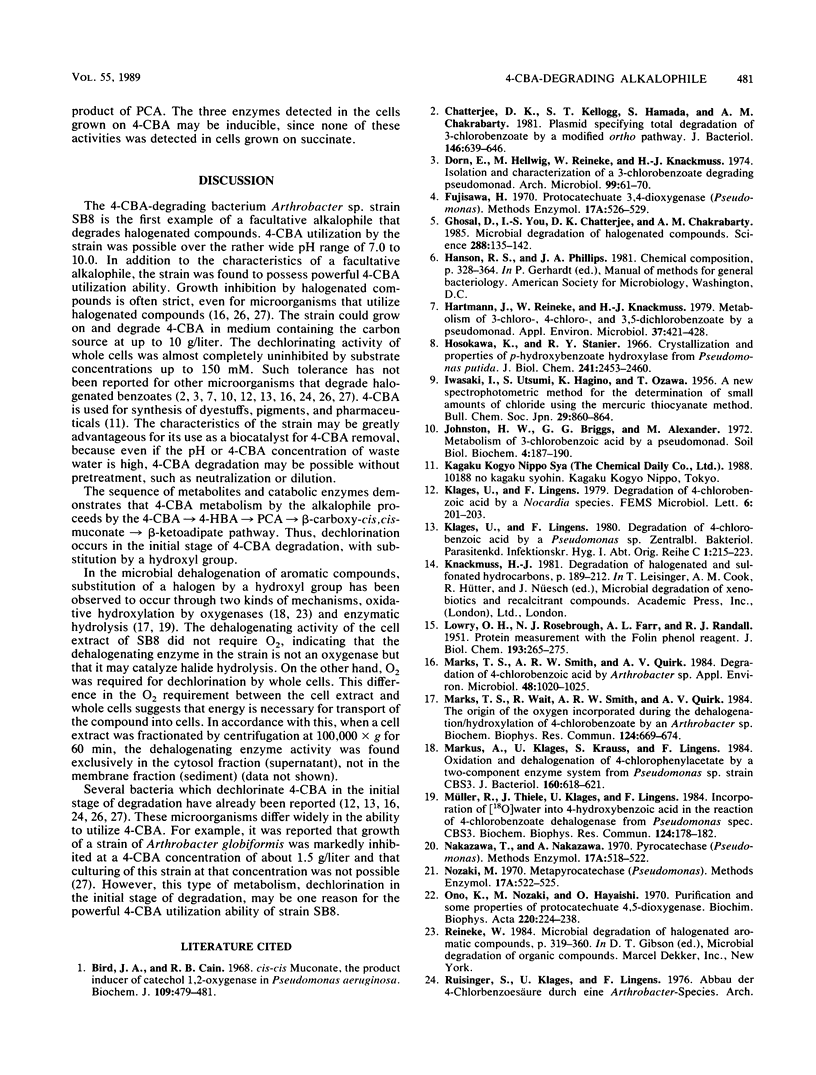Abstract
A facultative alkalophile capable of utilizing 4-chlorobenzoate (4-CBA), strain SB8, was isolated from soil with an alkaline medium (pH 10.0) containing the haloaromatic compound as the carbon source. The strain, identified as an Arthrobacter sp., showed rather extensive 4-CBA-degrading ability. 4-CBA utilization by the strain was possible in the alkaline medium containing up to 10 g of the compound per liter. The 4-CBA-dechlorinating activity of resting cells was almost completely uninhibited by substrate concentrations up to 150 mM. The bacterium dehalogenated 4-CBA in the initial stage of the degradation and metabolized the compound via 4-hydroxybenzoate and protocatechuate. O2 was needed for 4-CBA dechlorination by resting cells but not by cell extracts. O2 was inhibitory to the 4-CBA dechlorination activity of cell extracts. These facts suggest dechlorination of 4-CBA by halide hydrolysis and an energy requirement for the transport of 4-CBA into cells.
Full text
PDF




Selected References
These references are in PubMed. This may not be the complete list of references from this article.
- Bird J. A., Cain R. B. cis-cis-Muconate, the product inducer of catechol 1,2-oxygenase in Pseudomonas aeruginosa. Biochem J. 1968 Sep;109(3):479–481. doi: 10.1042/bj1090479. [DOI] [PMC free article] [PubMed] [Google Scholar]
- Chatterjee D. K., Kellogg S. T., Hamada S., Chakrabarty A. M. Plasmid specifying total degradation of 3-chlorobenzoate by a modified ortho pathway. J Bacteriol. 1981 May;146(2):639–646. doi: 10.1128/jb.146.2.639-646.1981. [DOI] [PMC free article] [PubMed] [Google Scholar]
- Dorn E., Hellwig M., Reineke W., Knackmuss H. J. Isolation and characterization of a 3-chlorobenzoate degrading pseudomonad. Arch Microbiol. 1974;99(1):61–70. doi: 10.1007/BF00696222. [DOI] [PubMed] [Google Scholar]
- Ghosal D., You I. S., Chatterjee D. K., Chakrabarty A. M. Microbial degradation of halogenated compounds. Science. 1985 Apr 12;228(4696):135–142. doi: 10.1126/science.228.4696.135. [DOI] [PubMed] [Google Scholar]
- Hartmann J., Reineke W., Knackmuss H. J. Metabolism of 3-chloro-, 4-chloro-, and 3,5-dichlorobenzoate by a pseudomonad. Appl Environ Microbiol. 1979 Mar;37(3):421–428. doi: 10.1128/aem.37.3.421-428.1979. [DOI] [PMC free article] [PubMed] [Google Scholar]
- Hosokawa K., Stanier R. Y. Crystallization and properties of p-hydroxybenzoate hydroxylase from Pseudomonas putida. J Biol Chem. 1966 May 25;241(10):2453–2460. [PubMed] [Google Scholar]
- LOWRY O. H., ROSEBROUGH N. J., FARR A. L., RANDALL R. J. Protein measurement with the Folin phenol reagent. J Biol Chem. 1951 Nov;193(1):265–275. [PubMed] [Google Scholar]
- Marks T. S., Smith A. R., Quirk A. V. Degradation of 4-Chlorobenzoic Acid by Arthrobacter sp. Appl Environ Microbiol. 1984 Nov;48(5):1020–1025. doi: 10.1128/aem.48.5.1020-1025.1984. [DOI] [PMC free article] [PubMed] [Google Scholar]
- Marks T. S., Wait R., Smith A. R., Quirk A. V. The origin of the oxygen incorporated during the dehalogenation/hydroxylation of 4-chlorobenzoate by an Arthrobacter sp. Biochem Biophys Res Commun. 1984 Oct 30;124(2):669–674. doi: 10.1016/0006-291x(84)91607-3. [DOI] [PubMed] [Google Scholar]
- Markus A., Klages U., Krauss S., Lingens F. Oxidation and dehalogenation of 4-chlorophenylacetate by a two-component enzyme system from Pseudomonas sp. strain CBS3. J Bacteriol. 1984 Nov;160(2):618–621. doi: 10.1128/jb.160.2.618-621.1984. [DOI] [PMC free article] [PubMed] [Google Scholar]
- Mires M. H., Alexander C. H. The prophylactic treatment tuberculosis. Del Med J. 1972 Jul;44(7):187–190. [PubMed] [Google Scholar]
- Müller R., Thiele J., Klages U., Lingens F. Incorporation of [18O]water into 4-hydroxybenzoic acid in the reaction of 4-chlorobenzoate dehalogenase from pseudomonas spec. CBS 3. Biochem Biophys Res Commun. 1984 Oct 15;124(1):178–182. doi: 10.1016/0006-291x(84)90933-1. [DOI] [PubMed] [Google Scholar]
- Ono K., Nozaki M., Hayaishi O. Purification and some properties of protocatechuate 4,5-dioxygenase. Biochim Biophys Acta. 1970 Nov 11;220(2):224–238. doi: 10.1016/0005-2744(70)90008-2. [DOI] [PubMed] [Google Scholar]
- Zaitsev G. M., Karasevich Iu N. Utilizatsiia 4-khlorbenzoinoi kisloty Arthrobacter globiformis. Mikrobiologiia. 1981 Jan-Feb;50(1):35–40. [PubMed] [Google Scholar]
- van den Tweel W. J., Kok J. B., de Bont J. A. Reductive dechlorination of 2,4-dichlorobenzoate to 4-chlorobenzoate and hydrolytic dehalogenation of 4-chloro-, 4-bromo-, and 4-iodobenzoate by Alcaligenes denitrificans NTB-1. Appl Environ Microbiol. 1987 Apr;53(4):810–815. doi: 10.1128/aem.53.4.810-815.1987. [DOI] [PMC free article] [PubMed] [Google Scholar]


